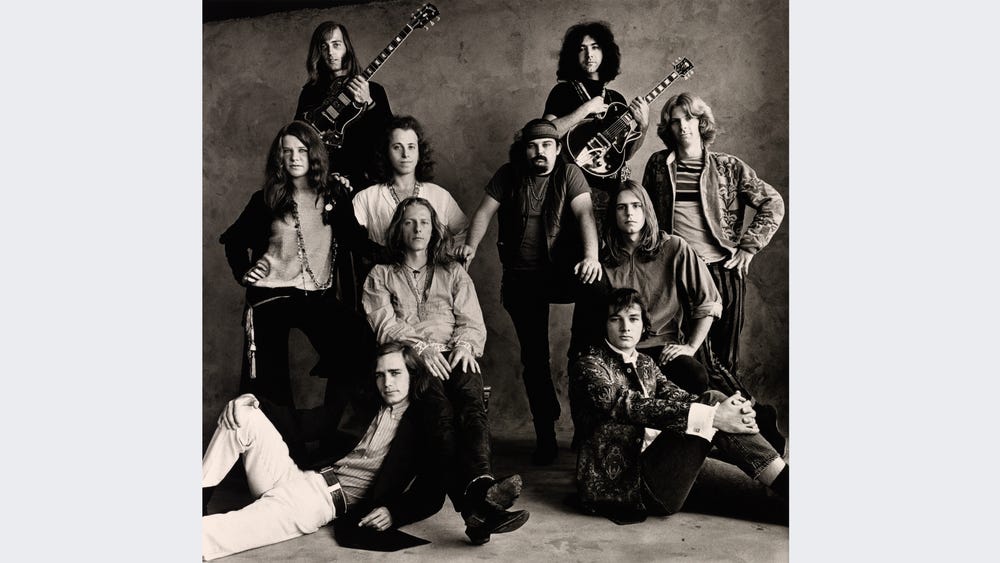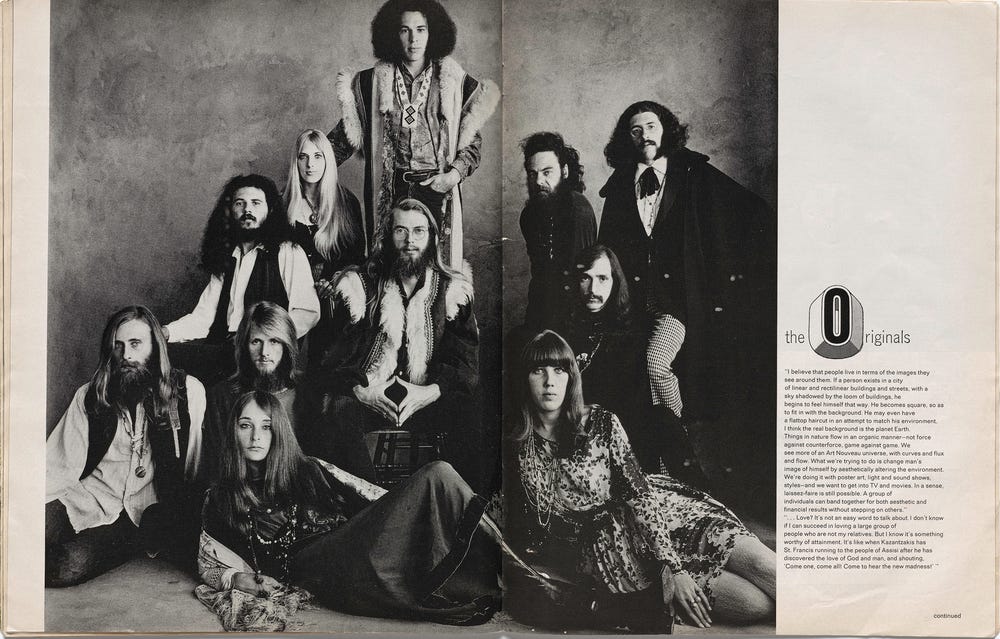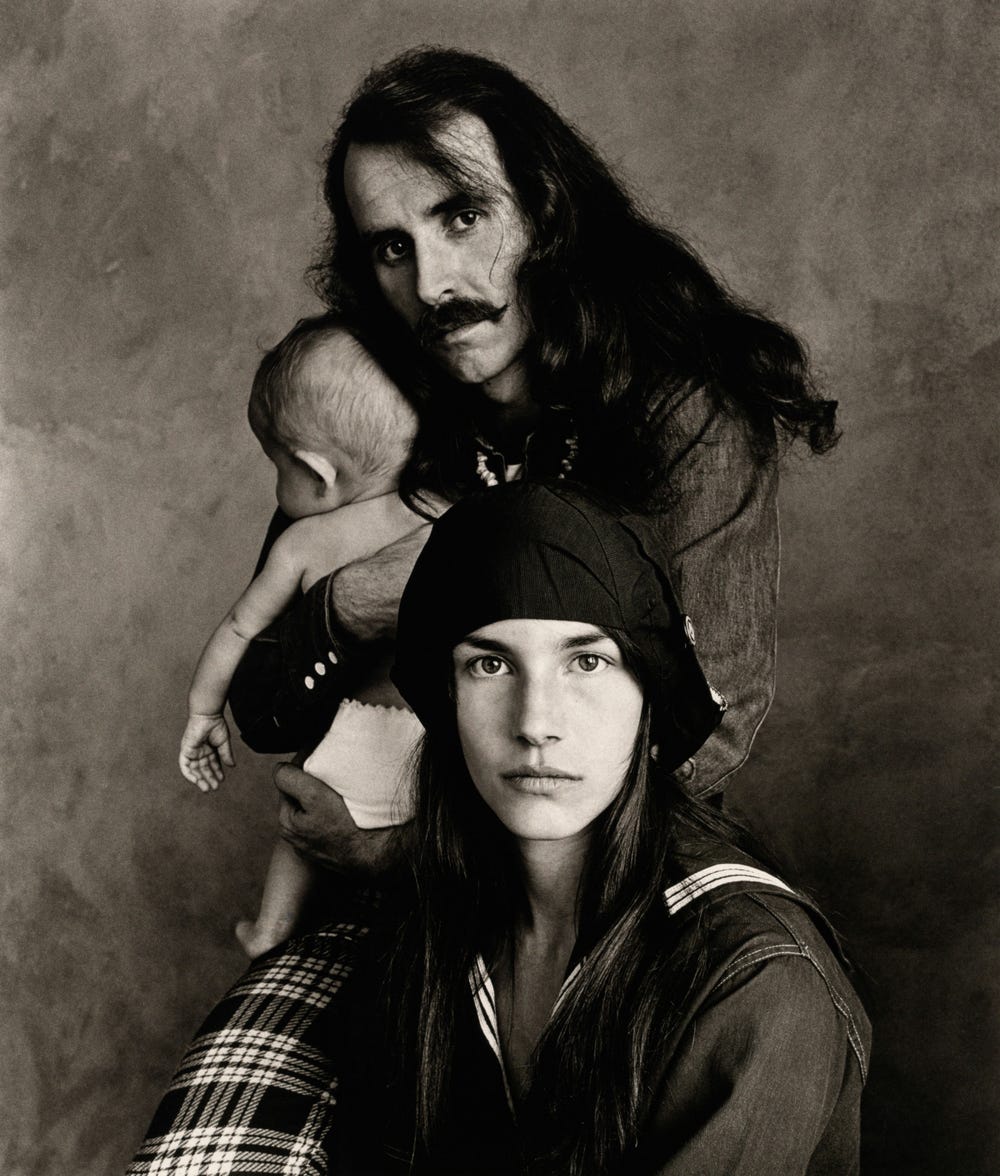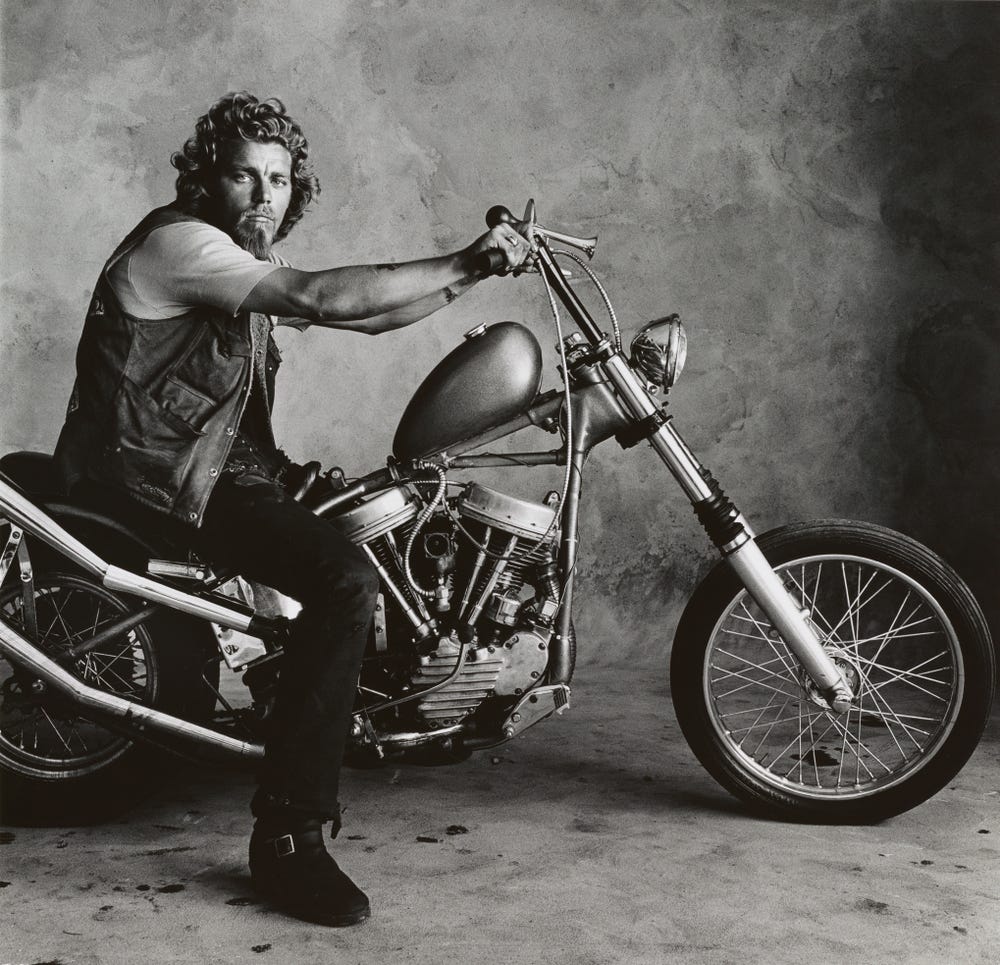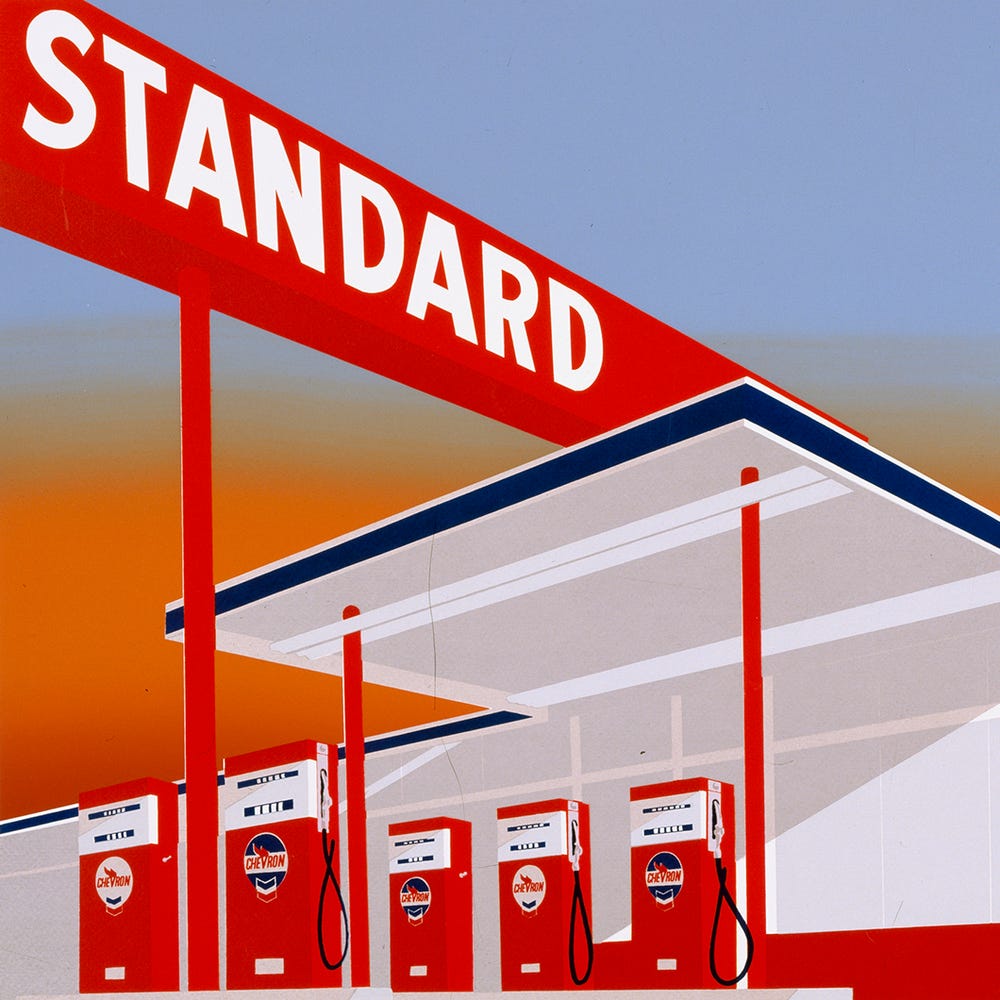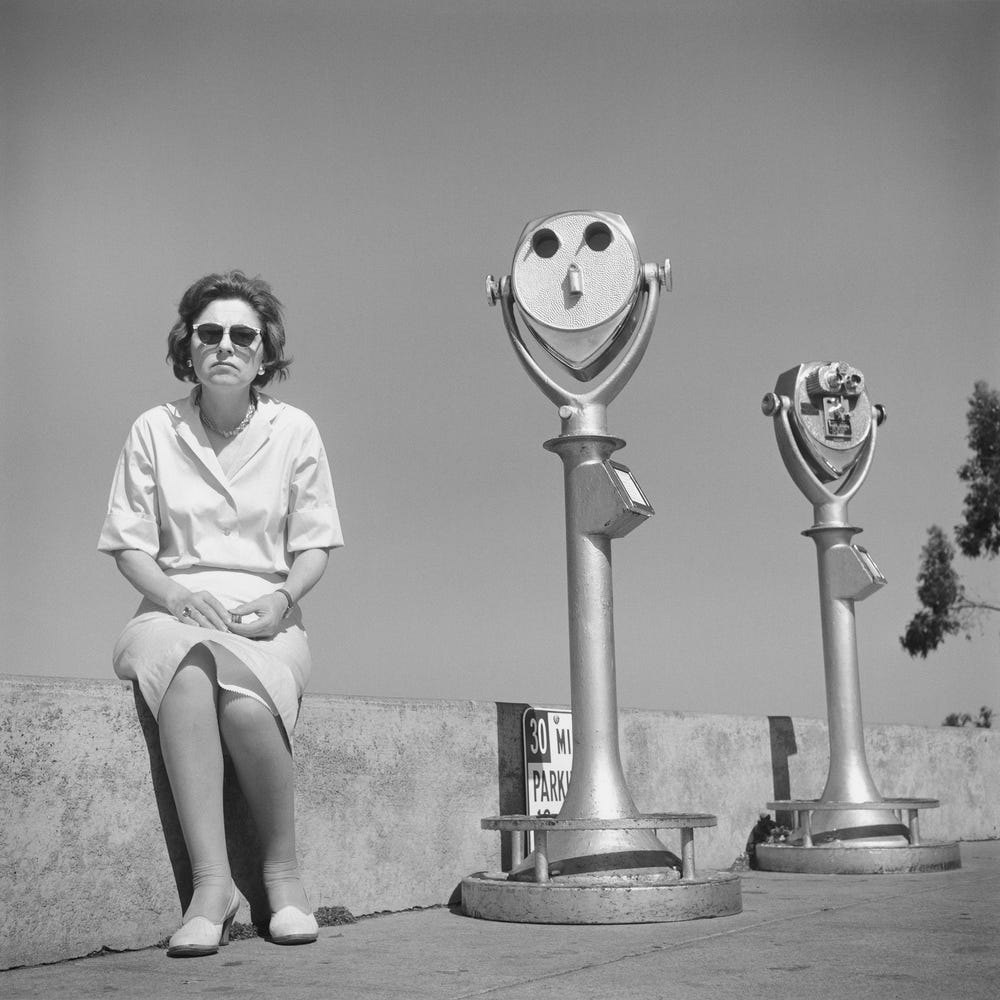Irving Penn, Rock Groups (Big Brother and the Holding Company and The Grateful Dead), San Francisco (detail), 1967, printed December 1979. Platinum-palladium print, 19 × 19 3/4 in. (48.3 × 50.2 cm). The Irving Penn Foundation. © The Irving Penn Foundation
In 1967, there was word coming out of San Francisco of something stirring — new ways of living that were exotic even for California. People spoke of a new kind of young people called hippies, and of an area where they had begun to congregate called Haight-Ashbury. They seemed to have found a satisfying new life for themselves in leaving the society they were born to and making their own. There was talk of drugs, communal living, and group sex. There were a new kind of music and new musicians, and accompanying the music there was a new visual form, the light show.
— Irving Penn, Worlds in a Small Room, 1974
In the mid-1960s, artists, writers, and musicians began moving into San Francisco’s Haight-Ashbury neighborhood. Brimming with creative energy, they had aspirations of creating a new society free from the constraints and prejudices of preceding generations. By the summer of 1967, what became known as the “Summer of Love,” the neighborhood had attracted as many as 100,000 young people from across the nation. Many were united in their opposition to the Vietnam War and their rejection of the materialist values of modern America.
The Summer of Love attracted widespread media attention, and articles about the hippie gatherings in San Francisco appeared in publications such as Time, Newsweek, and the New York Times Magazine. Photographer Irving Penn (1917–2009) proposed his own story on California’s countercultural movement to the editors of Look magazine.
Spread from January 9, 1968 issue of Look in an essay titled “The Incredibles”
Penn’s portraits of hippie families, Hells Angels, and rock bands were published in the January 9, 1968 issue of Look in an essay titled “The Incredibles.” These images were later published in Worlds in a Small Room (Penguin Books: 1974). The book contained work from several of Penn’s related series, beginning with photographs he took in 1948 in Cuzco, Peru, through his portraits from Spain, New Guinea, Greece, Cameroon, present-day Benin, Nepal, and Morocco, as well as the photographs of laborers in his 1950–1951 series Small Trades.
For the Look project, Penn rented space in a building in Sausalito and set up a makeshift studio. Since he only used available sunlight to photograph, the northern exposure of the space was critical.
Electric lights are a convenience, but they are used, I believe, at the expense of that simple three-dimensional clarity, that absolute existence that a subject has standing before a camera in a north-light studio.
— Irving Penn, Worlds in a Small Room, 1974
Penn constructed a concrete wall as a backdrop for his portraits. The neutral environment recalled those he used for previous series, including his 1950 studies of Paris high fashion and the photographs of laborers in Small Trades.
Irving Penn, Hippie Family (Kelley), San Francisco, 1967, printed January 1981. Platinum-palladium print, 16 5/8 × 14 3/16 in. (42.2 × 36 cm). The Irving Penn Foundation. © The Irving Penn Foundation
In his photographs of “two beautiful young hippie families of San Francisco,” Penn recorded the closeness of his subjects’ romantic and familial relationships, while also capturing their unapologetic nonconformism and unconventional style. Dynamic group portraits, such as Rock Groups, San Francisco (Big Brother and the Holding Company and The Grateful Dead) (1967) document the legendary musicians who provided the soundtrack to the Summer of Love, known as the San Francisco Sound.
Penn’s photographs of California counterculture include several portraits of members of the Hells Angels Motorcycle Club, founded in 1948 in Fontana, California. Penn instructed his subjects to ride their Harley motorcycles into the freight elevator of the rented building, then head up to the studio on the second floor to pose on their bikes. Penn described his subjects as “coiled springs ready to fly loose and make trouble,” admitting “when the experience was over and their screaming bikes went down the road, I breathed my deepest sigh.”
Irving Penn, Hell's Angel (Doug), San Francisco, 1967, printed before 1975. Gelatin silver print, 18 13/16 x 19 11/16 in. (47.8 x 50 cm.). The Metropolitan Museum of Art, Gift of The Irving Penn Foundation, 2021 © The Irving Penn Foundation
Penn also photographed members of the experimental dance group San Francisco Dancers’ Workshop. The avant-garde dancer and choreographer Anna Halprin founded the group in 1959 with dancers Trisha Brown, Simone Forti, and Yvonne Rainer; composer John Cage; and artist Robert Morris. Interested in challenging traditional notions of dance, Halprin invited individuals from a variety of artistic disciplines to join her workshops, with the goal of merging dance with other art forms. The groundbreaking, often participatory, dances she choreographed typically took place outside traditional performance settings. Penn documented the group performing their dance “The Bath” in the nude. His images of the dance were not included in “The Incredibles” article, but he printed a group of them for Halprin in 1995.
Irving Penn (1917–2009), The Bath, 1967. Gelatin silver print, 15 1/4 x 15 3/8 in. (38.7 x 39.1 cm). Fine Arts Museums of San Francisco, Museum purchase, Phyllis C. Wattis Fund for Major Accessions © The Irving Penn Foundation. Photograph by Jorge Bachmann
Penn’s Summer of Love photographs capture a moment of electrifying social change, which forever altered the cultural landscape of the Bay Area. Our presentation of Irving Penn includes an expanded selection of these portraits, emphasizing our location at the epicenter of this major countercultural movement.
